The Downscaled GOME-2 SIF Based on Machine Learning Enhances the Correlation with Ecosystem Productivity
Abstract
1. Introduction
2. Materials and Methods
2.1. Materials
2.1.1. Explanatory Variable
2.1.2. GOME-2 SIF Data
2.1.3. Validation Data
2.2. Method
2.2.1. Selection of Downscaling Algorithm
2.2.2. Downscaling Process and Data Preprocessing
3. Results
3.1. Model Comparison and Accuracy Evaluation
3.2. Verification of HRSIF
3.2.1. Comparison with Ground-Based Observations
3.2.2. Comparison with Other Satellite Products
3.3. Characteristics of the Spatial and Temporal Distribution of HRSIF
3.4. Correlation of HRSIF and GPP Under Different Land Use Types
4. Discussion
4.1. The Necessity of Comparing Different Research Methods
4.2. Impact of the Choice of Explanatory Variables on the Model
4.3. The Limitations of the Model and Future Improvements
5. Conclusions
Author Contributions
Funding
Data Availability Statement
Acknowledgments
Conflicts of Interest
References
- Zhang, Z.; Cescatti, A.; Wang, Y.-P.; Gentine, P.; Xiao, J.; Guanter, L.; Huete, A.R.; Wu, J.; Chen, J.M.; Ju, W.; et al. Large Diurnal Compensatory Effects Mitigate the Response of Amazonian Forests to Atmospheric Warming and Drying. Sci. Adv. 2023, 9, eabq4974. [Google Scholar] [CrossRef]
- Li, W.; Pacheco-Labrador, J.; Migliavacca, M.; Miralles, D.; Hoek van Dijke, A.; Reichstein, M.; Forkel, M.; Zhang, W.; Frankenberg, C.; Panwar, A.; et al. Widespread and Complex Drought Effects on Vegetation Physiology Inferred from Space. Nat. Commun. 2023, 14, 4640. [Google Scholar] [CrossRef] [PubMed]
- Zarco-Tejada, P.J.; Poblete, T.; Camino, C.; Gonzalez-Dugo, V.; Calderon, R.; Hornero, A.; Hernandez-Clemente, R.; Román-Écija, M.; Velasco-Amo, M.P.; Landa, B.B.; et al. Divergent Abiotic Spectral Pathways Unravel Pathogen Stress Signals across Species. Nat. Commun. 2021, 12, 6088. [Google Scholar] [CrossRef] [PubMed]
- Joiner, J.; Yoshida, Y.; Vasilkov, A.P.; Yoshida, Y.; Corp, L.A.; Middleton, E.M. First Observations of Global and Seasonal Terrestrial Chlorophyll Fluorescence from Space. Biogeosciences 2011, 8, 637–651. [Google Scholar] [CrossRef]
- Sun, Y.; Frankenberg, C.; Wood, J.D.; Schimel, D.S.; Jung, M.; Guanter, L.; Drewry, D.T.; Verma, M.; Porcar-Castell, A.; Griffis, T.J.; et al. OCO-2 Advances Photosynthesis Observation from Space via Solar-Induced Chlorophyll Fluorescence. Science 2017, 358, eaam5747. [Google Scholar] [CrossRef]
- Köhler, P.; Frankenberg, C.; Magney, T.S.; Guanter, L.; Joiner, J.; Landgraf, J. Global Retrievals of Solar-Induced Chlorophyll Fluorescence With TROPOMI: First Results and Intersensor Comparison to OCO-2. Geophys. Res. Lett. 2018, 45, 10456–10463. [Google Scholar] [CrossRef]
- Zhang, Z.; Guanter, L.; Porcar-Castell, A.; Rossini, M.; Pacheco-Labrador, J.; Zhang, Y. Global Modeling Diurnal Gross Primary Production from OCO-3 Solar-Induced Chlorophyll Fluorescence. Remote Sens. Environ. 2023, 285, 113383. [Google Scholar] [CrossRef]
- Buareal, K.; Kato, T.; Morozumi, T.; Ono, K.; Nakashima, N. Red Solar-Induced Chlorophyll Fluorescence as a Robust Proxy for Ecosystem-Level Photosynthesis in a Rice Field. Agric. For. Meteorol. 2023, 336, 109473. [Google Scholar] [CrossRef]
- Wen, J.; Köhler, P.; Duveiller, G.; Parazoo, N.C.; Magney, T.S.; Hooker, G.; Yu, L.; Chang, C.Y.; Sun, Y. A Framework for Harmonizing Multiple Satellite Instruments to Generate a Long-Term Global High Spatial-Resolution Solar-Induced Chlorophyll Fluorescence (SIF). Remote Sens. Environ. 2020, 239, 111644. [Google Scholar] [CrossRef]
- Ma, Y.; Liu, L.; Liu, X.; Chen, J. An Improved Downscaled Sun-Induced Chlorophyll Fluorescence (DSIF) Product of GOME-2 Dataset. Eur. J. Remote Sens. 2022, 55, 168–180. [Google Scholar] [CrossRef]
- Chen, S.; Liu, L.; Sui, L.; Liu, X.; Ma, Y. An Improved Spatially Downscaled Solar-Induced Chlorophyll Fluorescence Dataset from the TROPOMI Product. Sci. Data 2025, 12, 135. [Google Scholar] [CrossRef]
- Chen, X.; Huang, Y.; Nie, C.; Zhang, S.; Wang, G.; Chen, S.; Chen, Z. A Long-Term Reconstructed TROPOMI Solar-Induced Fluorescence Dataset Using Machine Learning Algorithms. Sci. Data 2022, 9, 427. [Google Scholar] [CrossRef]
- Li, X.; Xiao, J. Mapping Photosynthesis Solely from Solar-Induced Chlorophyll Fluorescence: A Global, Fine-Resolution Dataset of Gross Primary Production Derived from OCO-2. Remote Sens. 2019, 11, 2563. [Google Scholar] [CrossRef]
- Duveiller, G.; Cescatti, A. Spatially Downscaling Sun-Induced Chlorophyll Fluorescence Leads to an Improved Temporal Correlation with Gross Primary Productivity. Remote Sens. Environ. 2016, 182, 72–89. [Google Scholar] [CrossRef]
- Yu, L.; Wen, J.; Chang, C.Y.; Frankenberg, C.; Sun, Y. High-Resolution Global Contiguous SIF of OCO-2. Geophys. Res. Lett. 2019, 46, 1449–1458. [Google Scholar] [CrossRef]
- Running, S.W.; Nemani, R.R.; Heinsch, F.A.; Zhao, M.; Reeves, M.; Hashimoto, H. A Continuous Satellite-Derived Measure of Global Terrestrial Primary Production. BioScience 2004, 54, 547–560. [Google Scholar] [CrossRef]
- Impollonia, G.; Croci, M.; Amaducci, S. Upscaling and Downscaling Approaches for Early Season Rice Yield Prediction Using Sentinel-2 and Machine Learning for Precision Nitrogen Fertilisation. Comput. Electron. Agric. 2024, 227, 109603. [Google Scholar] [CrossRef]
- Sorkhabi, O.M.; Awange, J. Long Short-Term Memory Exploitation of Satellite Gravimetry to Infer Floods. Int. J. Appl. Earth Obs. Geoinf. 2025, 139, 104562. [Google Scholar] [CrossRef]
- He, S.; Yuan, Y.; Dong, H.; Chen, X.; Zhang, C. A Geographically Random Machine Learning Model for GOME-2 Global Seamless Sun-Induced Chlorophyll Fluorescence Downscaling Products With High Spatiotemporal Resolution. IEEE Trans. Geosci. Remote Sens. 2025, 63, 1–15. [Google Scholar] [CrossRef]
- Grinsztajn, L.; Oyallon, E.; Varoquaux, G. Why Do Tree-Based Models Still Outperform Deep Learning on Tabular Data? arXiv 2022, arXiv:2207.08815. [Google Scholar]
- Gensheimer, J.; Turner, A.J.; Köhler, P.; Frankenberg, C.; Chen, J. A Convolutional Neural Network for Spatial Downscaling of Satellite-Based Solar-Induced Chlorophyll Fluorescence (SIFnet). Biogeosciences 2022, 19, 1777–1793. [Google Scholar] [CrossRef]
- Saha, S.; Roy, J.; Hembram, T.K.; Pradhan, B.; Dikshit, A.; Abdul Maulud, K.N.; Alamri, A.M. Comparison between Deep Learning and Tree-Based Machine Learning Approaches for Landslide Susceptibility Mapping. Water 2021, 13, 2664. [Google Scholar] [CrossRef]
- Zhang, Y.; Zhang, Q.; Liu, L.; Zhang, Y.; Wang, S.; Ju, W.; Zhou, G.; Zhou, L.; Tang, J.; Zhu, X.; et al. ChinaSpec: A Network for Long-Term Ground-Based Measurements of Solar-Induced Fluorescence in China. J. Geophys. Res. Biogeosci. 2021, 126, e2020JG006042. [Google Scholar] [CrossRef]
- Schaaf, C.; Wang, Z. MODIS/Terra+Aqua BRDF/Albedo Nadir BRDF-Adjusted Ref Daily L3 Global 0.05Deg CMG V061; NASA Land Processes Distributed Active Archive Center: Sioux Falls, SD, USA, 2021. [Google Scholar]
- Wan, Z.; Hook, S.; Hulley, G. MODIS/Terra Land Surface Temperature/Emissivity Daily L3 Global 0.05Deg CMG V061; NASA Land Processes Distributed Active Archive Center: Sioux Falls, SD, USA, 2021. [Google Scholar]
- Friedl, M.; Sulla-Menashe, D. MODIS/Terra+Aqua Land Cover Type Yearly L3 Global 0.05Deg CMG V061; NASA Land Processes Distributed Active Archive Center: Sioux Falls, SD, USA, 2022. [Google Scholar]
- Wielicki, B.A.; Barkstrom, B.R.; Harrison, E.F.; Lee, R.B.; Smith, G.L.; Cooper, J.E. Clouds and the Earth’s Radiant Energy System (CERES): An Earth Observing System Experiment. Bull. Am. Meteorol. Soc. 1996, 77, 853–868. [Google Scholar] [CrossRef]
- Joiner, J.; Guanter, L.; Lindstrot, R.; Voigt, M.; Vasilkov, A.P.; Middleton, E.M.; Huemmrich, K.F.; Yoshida, Y.; Frankenberg, C. Global Monitoring of Terrestrial Chlorophyll Fluorescence from Moderate-Spectral-Resolution near-Infrared Satellite Measurements: Methodology, Simulations, and Application to GOME-2. Atmos. Meas. Tech. 2013, 6, 2803–2823. [Google Scholar] [CrossRef]
- Köhler, P.; Guanter, L.; Joiner, J. A Linear Method for the Retrieval of Sun-Induced Chlorophyll Fluorescence from GOME-2 and SCIAMACHY Data. Atmos. Meas. Tech. 2015, 8, 2589–2608. [Google Scholar] [CrossRef]
- Grossmann, K.; Frankenberg, C.; Magney, T.S.; Hurlock, S.C.; Seibt, U.; Stutz, J. PhotoSpec: A New Instrument to Measure Spatially Distributed Red and Far-Red Solar-Induced Chlorophyll Fluorescence. Remote Sens. Environ. 2018, 216, 311–327. [Google Scholar] [CrossRef]
- Du, S.; Liu, L.; Liu, X.; Guo, J.; Hu, J.; Wang, S.; Zhang, Y. SIFSpec: Measuring Solar-Induced Chlorophyll Fluorescence Observations for Remote Sensing of Photosynthesis. Sensors 2019, 19, 3009. [Google Scholar] [CrossRef] [PubMed]
- Magney, T.; Frankenberg, C.; Stutz, J.; Grossmann, K. PhotoSpec Solar-Induced Fluorescence and Meteorological Data: Corn, Iowa. 2017. Available online: https://data.caltech.edu/records/em9wn-ntq87 (accessed on 27 July 2025).
- Pierrat, Z.; Stutz, J. Tower-Based Solar-Induced Fluorescence and Vegetation Index Data for Southern Old Black Spruce Forest. Available online: https://zenodo.org/records/7596931 (accessed on 27 July 2025).
- Zhang, Q.; Zhang, X.; Li, Z.; Wu, Y.; Zhang, Y. Comparison of Bi-Hemispherical and Hemispherical-Conical Configurations for In Situ Measurements of Solar-Induced Chlorophyll Fluorescence. Remote Sens. 2019, 11, 2642. [Google Scholar] [CrossRef]
- Liu, X.; Liu, L.; Bacour, C.; Guanter, L.; Chen, J.; Ma, Y.; Chen, R.; Du, S. A Simple Approach to Enhance the TROPOMI Solar-Induced Chlorophyll Fluorescence Product by Combining with Canopy Reflected Radiation at near-Infrared Band. Remote Sens. Environ. 2023, 284, 113341. [Google Scholar] [CrossRef]
- Duveiller, G.; Filipponi, F.; Walther, S.; Köhler, P.; Frankenberg, C.; Guanter, L.; Cescatti, A. A Spatially Downscaled Sun-Induced Fluorescence Global Product for Enhanced Monitoring of Vegetation Productivity. Earth Syst. Sci. Data 2020, 12, 1101–1116. [Google Scholar] [CrossRef]
- Chen, T.; Guestrin, C. XGBoost: A Scalable Tree Boosting System. In Proceedings of the 22nd ACM SIGKDD International Conference on Knowledge Discovery and Data Mining, San Francisco, CA, USA, 13–17 August 2016; Association for Computing Machinery: New York, NY, USA, 2016; pp. 785–794. [Google Scholar]
- Liu, X.; Guanter, L.; Liu, L.; Damm, A.; Malenovsky, Z.; Rascher, U.; Peng, D.; Du, S.; Gastellu-Etchegorry, J.-P. Downscaling of Solar-Induced Chlorophyll Fluorescence from Canopy Level to Photosystem Level Using a Random Forest Model. Remote Sens. Environ. 2019, 231, 110772. [Google Scholar] [CrossRef]
- Hesterman, J.Y.; Caucci, L.; Kupinski, M.A.; Barrett, H.H.; Furenlid, L.R. Maximum-Likelihood Estimation With a Contracting-Grid Search Algorithm. IEEE Trans. Nucl. Sci. 2010, 57, 1077–1084. [Google Scholar] [CrossRef]
- Li, X.; Xiao, J.; He, B.; Altaf Arain, M.; Beringer, J.; Desai, A.R.; Emmel, C.; Hollinger, D.Y.; Krasnova, A.; Mammarella, I.; et al. Solar-Induced Chlorophyll Fluorescence Is Strongly Correlated with Terrestrial Photosynthesis for a Wide Variety of Biomes: First Global Analysis Based on OCO-2 and Flux Tower Observations. Glob. Change Biol. 2018, 24, 3990–4008. [Google Scholar] [CrossRef]
- Huete, A.R.; Didan, K.; Shimabukuro, Y.E.; Ratana, P.; Saleska, S.R.; Hutyra, L.R.; Yang, W.; Nemani, R.R.; Myneni, R. Amazon Rainforests Green-up with Sunlight in Dry Season. Geophys. Res. Lett. 2006, 33, L06405. [Google Scholar] [CrossRef]
- Gentine, P.; Alemohammad, S.H. Reconstructed Solar-Induced Fluorescence: A Machine Learning Vegetation Product Based on MODIS Surface Reflectance to Reproduce GOME-2 Solar-Induced Fluorescence. Geophys. Res. Lett. 2018, 45, 3136–3146. [Google Scholar] [CrossRef] [PubMed]
- Damm, A.; Elbers, J.; Erler, A.; Gioli, B.; Hamdi, K.; Hutjes, R.; Kosvancova, M.; Meroni, M.; Miglietta, F.; Moersch, A.; et al. Remote Sensing of Sun-Induced Fluorescence to Improve Modeling of Diurnal Courses of Gross Primary Production (GPP). Glob. Change Biol. 2010, 16, 171–186. [Google Scholar] [CrossRef]
- Zeng, Y.; Hao, D.; Huete, A.; Dechant, B.; Berry, J.; Chen, J.M.; Joiner, J.; Frankenberg, C.; Bond-Lamberty, B.; Ryu, Y.; et al. Optical Vegetation Indices for Monitoring Terrestrial Ecosystems Globally. Nat. Rev. Earth Environ. 2022, 3, 477–493. [Google Scholar] [CrossRef]
- Yu, J.; Li, X.; Du, H.; Mao, F.; Xu, Y.; Huang, Z.; Zhao, Y.; Lv, L.; Song, M.; Huang, L.; et al. Solar-Induced Fluorescence-Based Phenology of Subtropical Forests in China and Its Response to Climate Factors. Agric. For. Meteorol. 2024, 356, 110182. [Google Scholar] [CrossRef]
- Zhu, W.; Xie, Z.; Zhao, C.; Zheng, Z.; Qiao, K.; Peng, D.; Fu, Y.H. Remote Sensing of Terrestrial Gross Primary Productivity: A Review of Advances in Theoretical Foundation, Key Parameters and Methods. GISci. Remote Sens. 2024, 61, 2318846. [Google Scholar] [CrossRef]
- Pastorello, G.; Trotta, C.; Canfora, E.; Chu, H.; Christianson, D.; Cheah, Y.-W.; Poindexter, C.; Chen, J.; Elbashandy, A.; Humphrey, M.; et al. The FLUXNET2015 Dataset and the ONEFlux Processing Pipeline for Eddy Covariance Data. Sci. Data 2020, 7, 225. [Google Scholar] [CrossRef]
- Martini, D.; Pacheco-Labrador, J.; Perez-Priego, O.; van der Tol, C.; El-Madany, T.S.; Julitta, T.; Rossini, M.; Reichstein, M.; Christiansen, R.; Rascher, U.; et al. Nitrogen and Phosphorus Effect on Sun-Induced Fluorescence and Gross Primary Productivity in Mediterranean Grassland. Remote Sens. 2019, 11, 2562. [Google Scholar] [CrossRef]
- Xu, E.; Zhou, L.; Ding, J.; Zhao, N.; Zeng, L.; Zhang, G.; Chi, Y. Physiological Dynamics Dominate the Relationship between Solar-Induced Chlorophyll Fluorescence and Gross Primary Productivity along the Nitrogen Gradient in Cropland. Sci. Total Environ. 2024, 929, 172725. [Google Scholar] [CrossRef]
- Wen, J.; Tagliabue, G.; Rossini, M.; Fava, F.P.; Panigada, C.; Merbold, L.; Leitner, S.; Sun, Y. Detection of Fast-Changing Intra-Seasonal Vegetation Dynamics of Drylands Using Solar-Induced Chlorophyll Fluorescence (SIF). Biogeosciences 2025, 22, 2049–2067. [Google Scholar] [CrossRef]
- Lundberg, S.M.; Lee, S.I. A Unified Approach to Interpreting Model Predictions. In Proceedings of the Neural Information Processing Systems, Long Beach, CA, USA, 4–9 December 2017. [Google Scholar]
- Li, X.; Xiao, J.; He, B. Chlorophyll Fluorescence Observed by OCO-2 Is Strongly Related to Gross Primary Productivity Estimated from Flux Towers in Temperate Forests. Remote Sens. Environ. 2018, 204, 659–671. [Google Scholar] [CrossRef]
- Grekousis, G. Geographical-XGBoost: A New Ensemble Model for Spatially Local Regression Based on Gradient-Boosted Trees. J. Geogr. Syst. 2025, 27, 169–195. [Google Scholar] [CrossRef]
- Lu, J.; Li, J.; Fu, H.; Zou, W.; Kang, J.; Yu, H.; Lin, X. Estimation of Rice Yield Using Multi-Source Remote Sensing Data Combined with Crop Growth Model and Deep Learning Algorithm. Agric. For. Meteorol. 2025, 370, 110600. [Google Scholar] [CrossRef]
- Ebel, P.; Meraner, A.; Schmitt, M.; Zhu, X.X. Multisensor Data Fusion for Cloud Removal in Global and All-Season Sentinel-2 Imagery. IEEE Trans. Geosci. Remote Sens. 2021, 59, 5866–5878. [Google Scholar] [CrossRef]
- Fang, L.; Jin, J.; Segers, A.; Li, K.; Xia, J.; Han, W.; Li, B.; Lin, H.X.; Zhu, L.; Liu, S.; et al. Observational Operator for Fair Model Evaluation with Ground NO2 Measurements. Geosci. Model. Dev. 2024, 17, 8267–8282. [Google Scholar] [CrossRef]
- Chen, Y.; Wang, Y.; Wu, C.; Jardim, A.M.d.R.F.; Fang, M.; Yao, L.; Liu, G.; Xu, Q.; Chen, L.; Tang, X. Drought-Induced Stress on Rainfed and Irrigated Agriculture: Insights from Multi-Source Satellite-Derived Ecological Indicators. Agric. Water Manag. 2025, 307, 109249. [Google Scholar] [CrossRef]
- Han, L.; Chen, Y.; Wu, C.; Yao, L.; Wang, Y.; Su, C.; Li, X.; da Rosa Ferraz Jardim, A.M.; Freire da Silva, T.G.; Tang, X. Divergent Drought-Induced Suppression on Vegetation and Associated Feedbacks: Satellite-Based Observations in 2022 across the Yangtze River Basin, China. J. Hydrol. 2025, 661, 133673. [Google Scholar] [CrossRef]
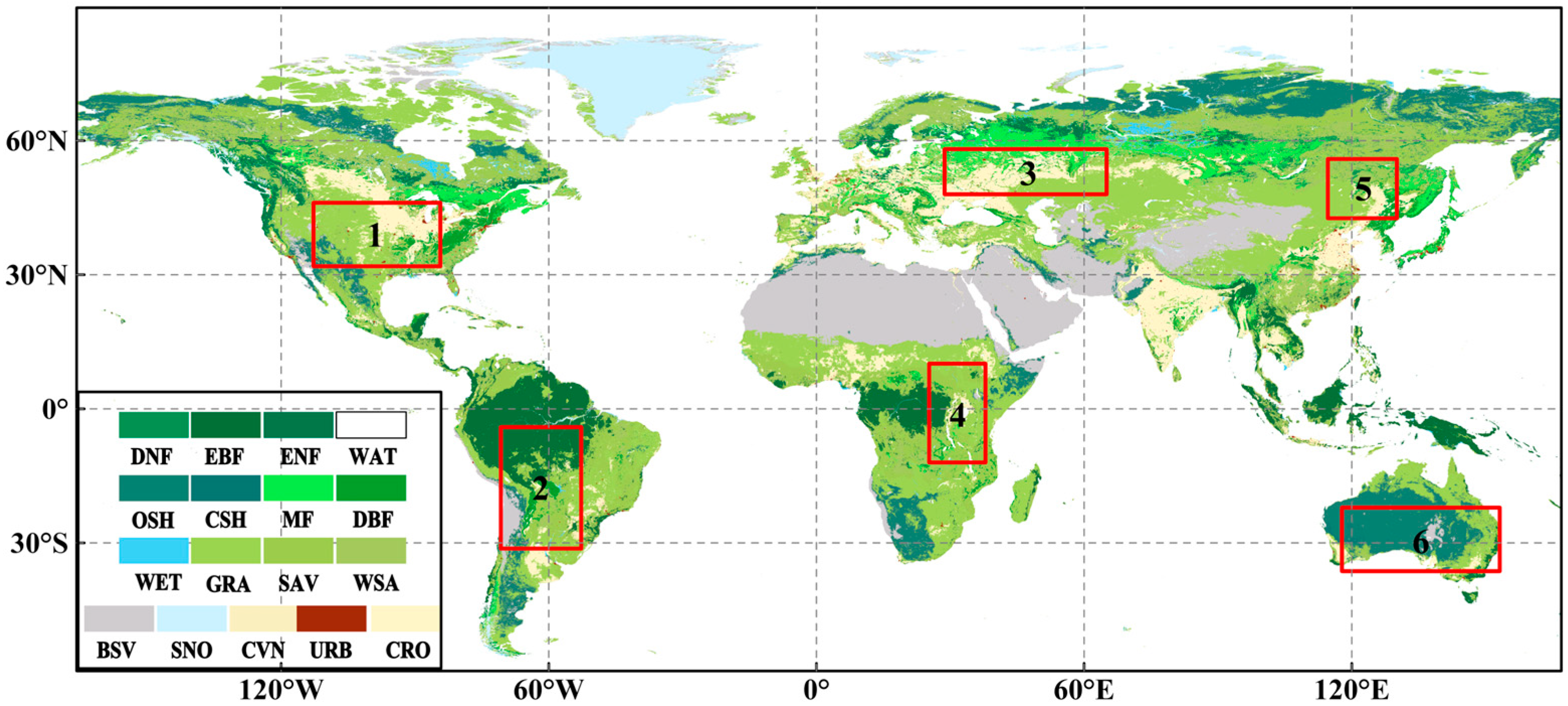
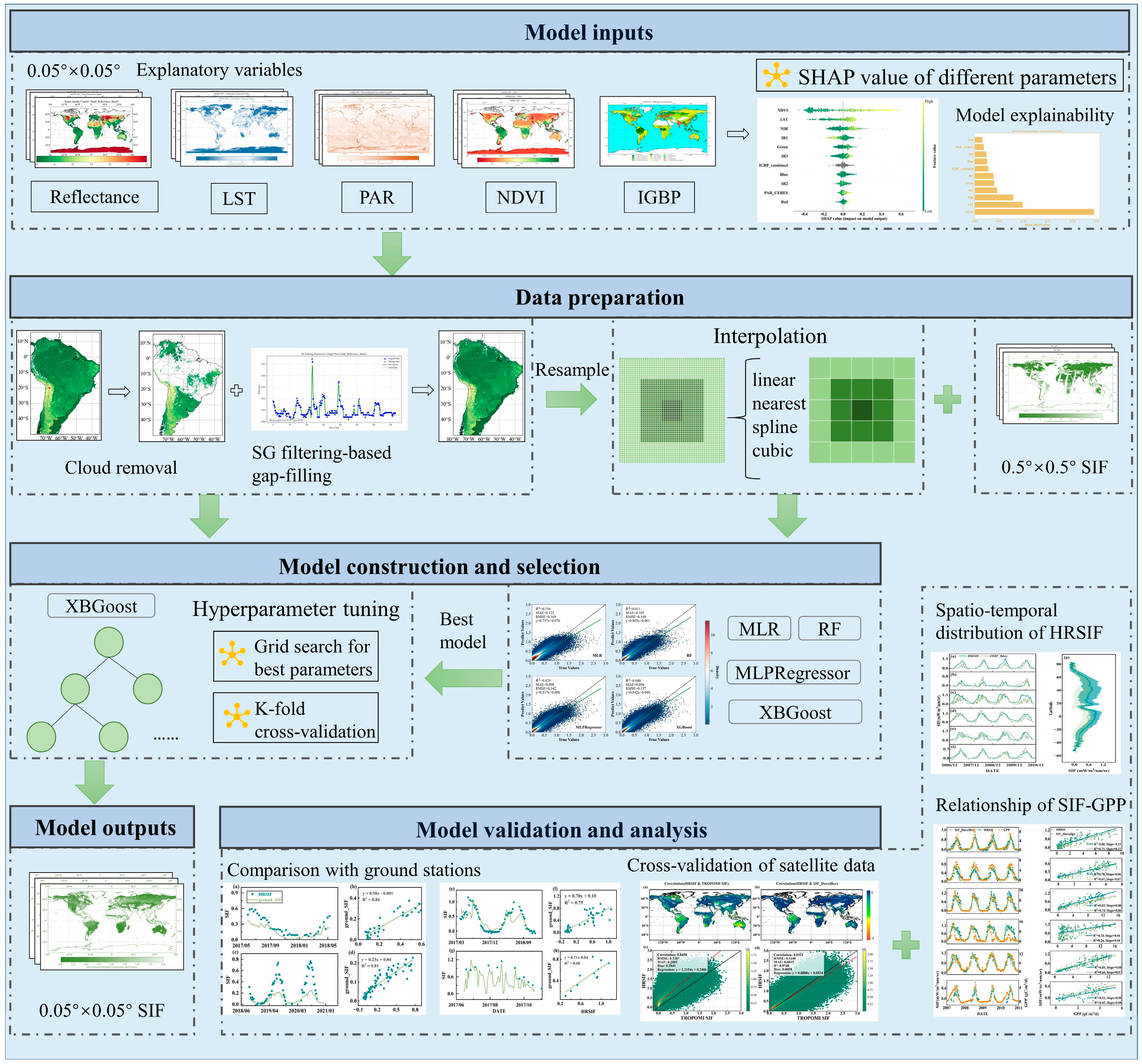
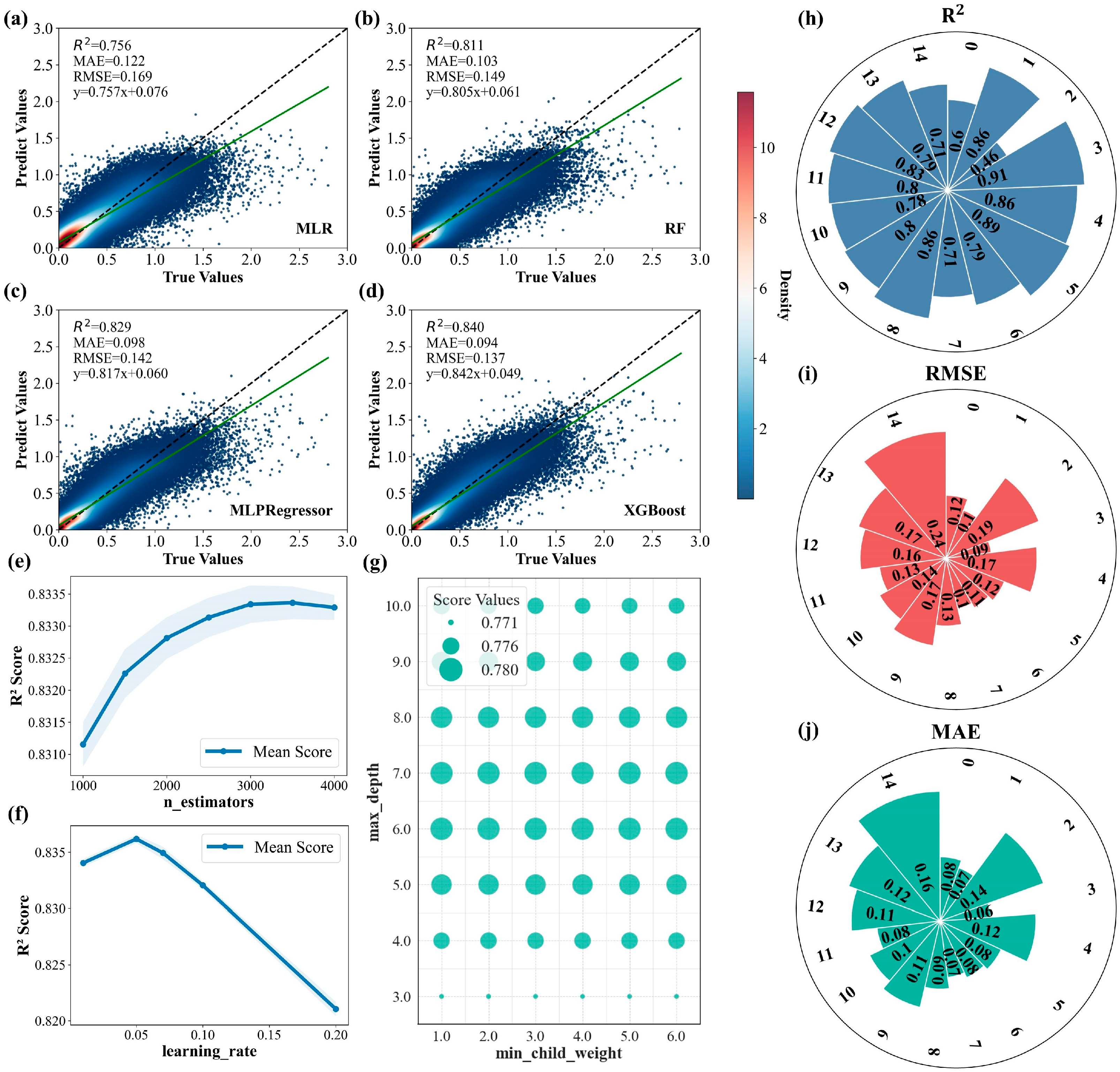
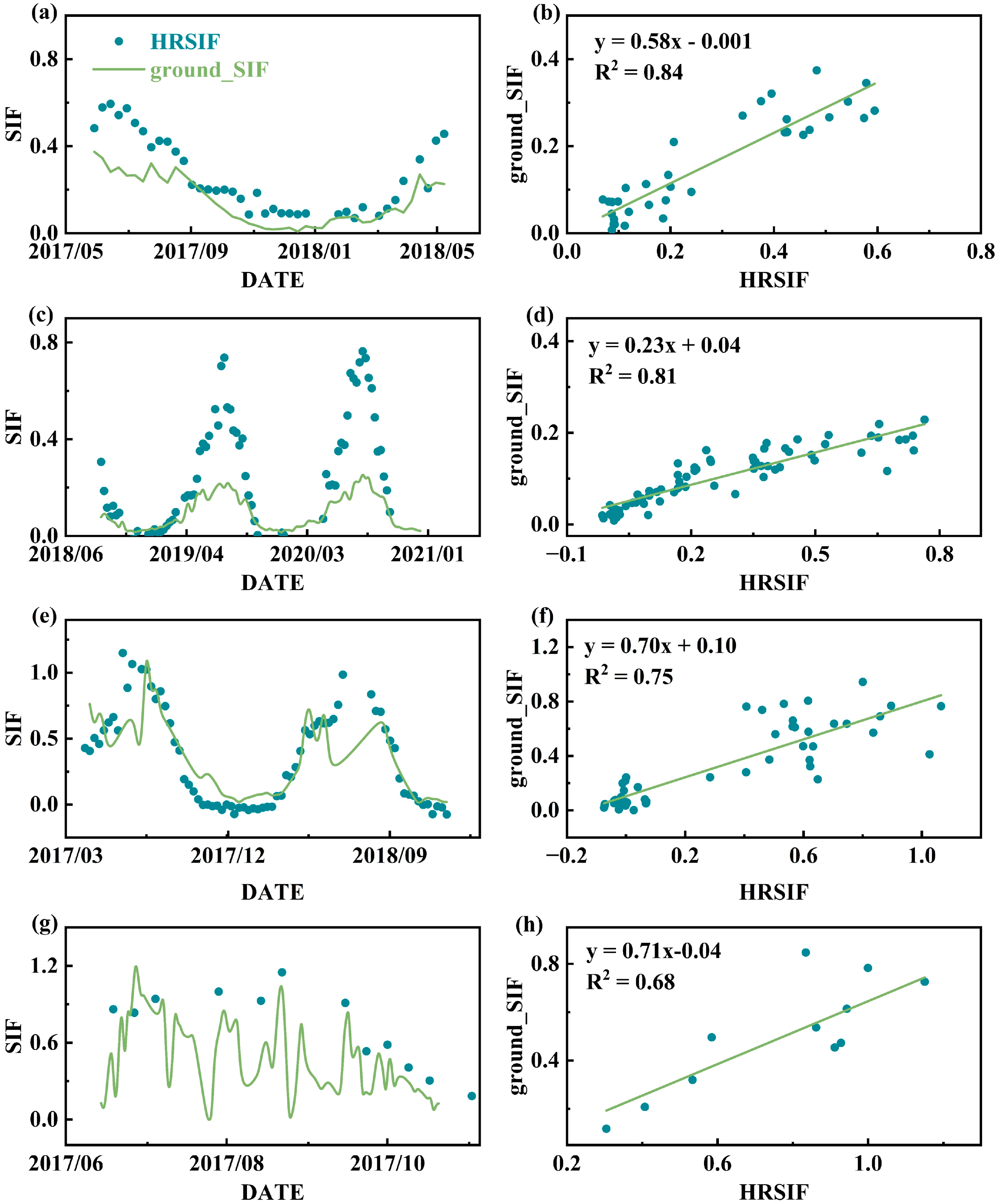
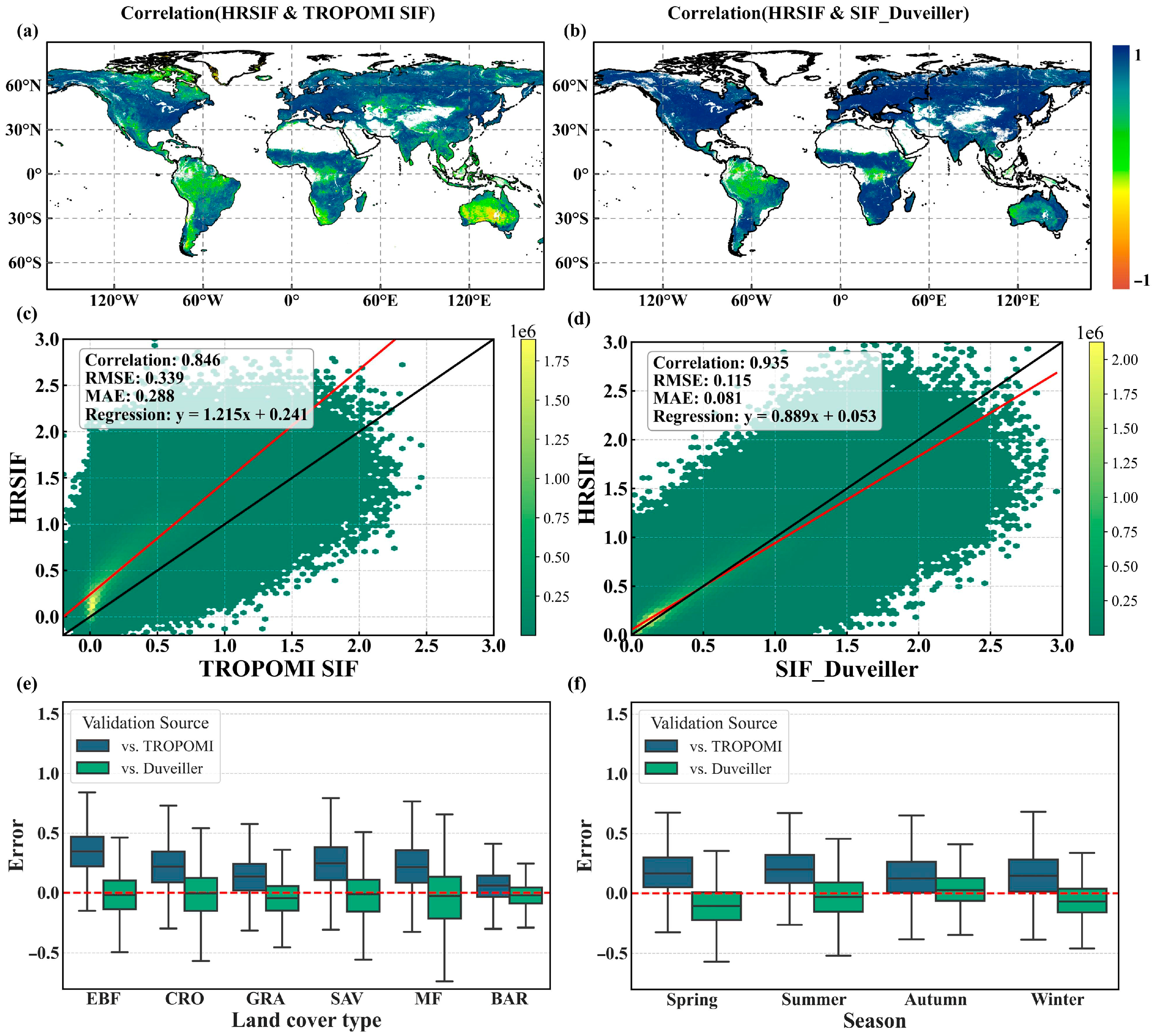
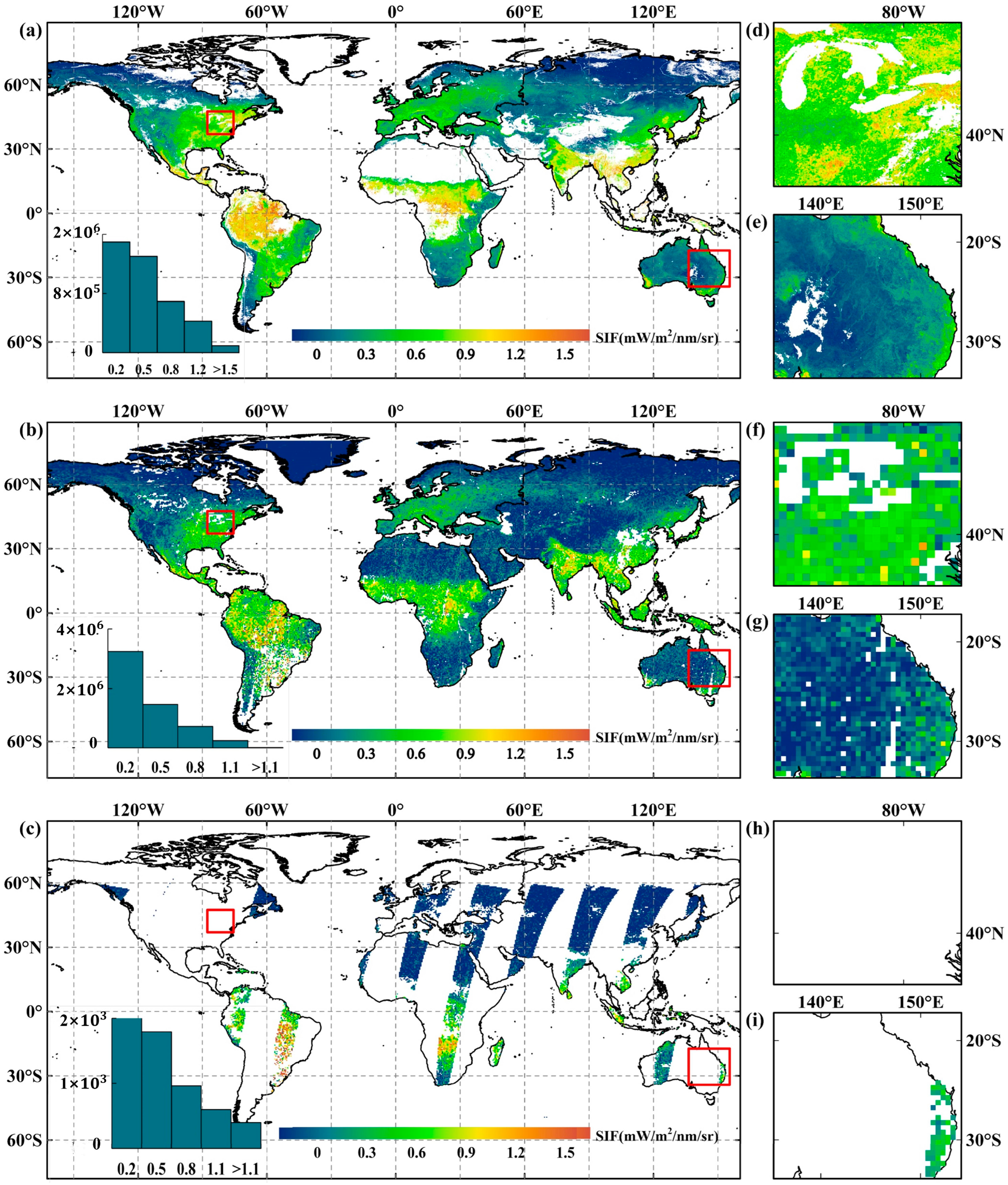
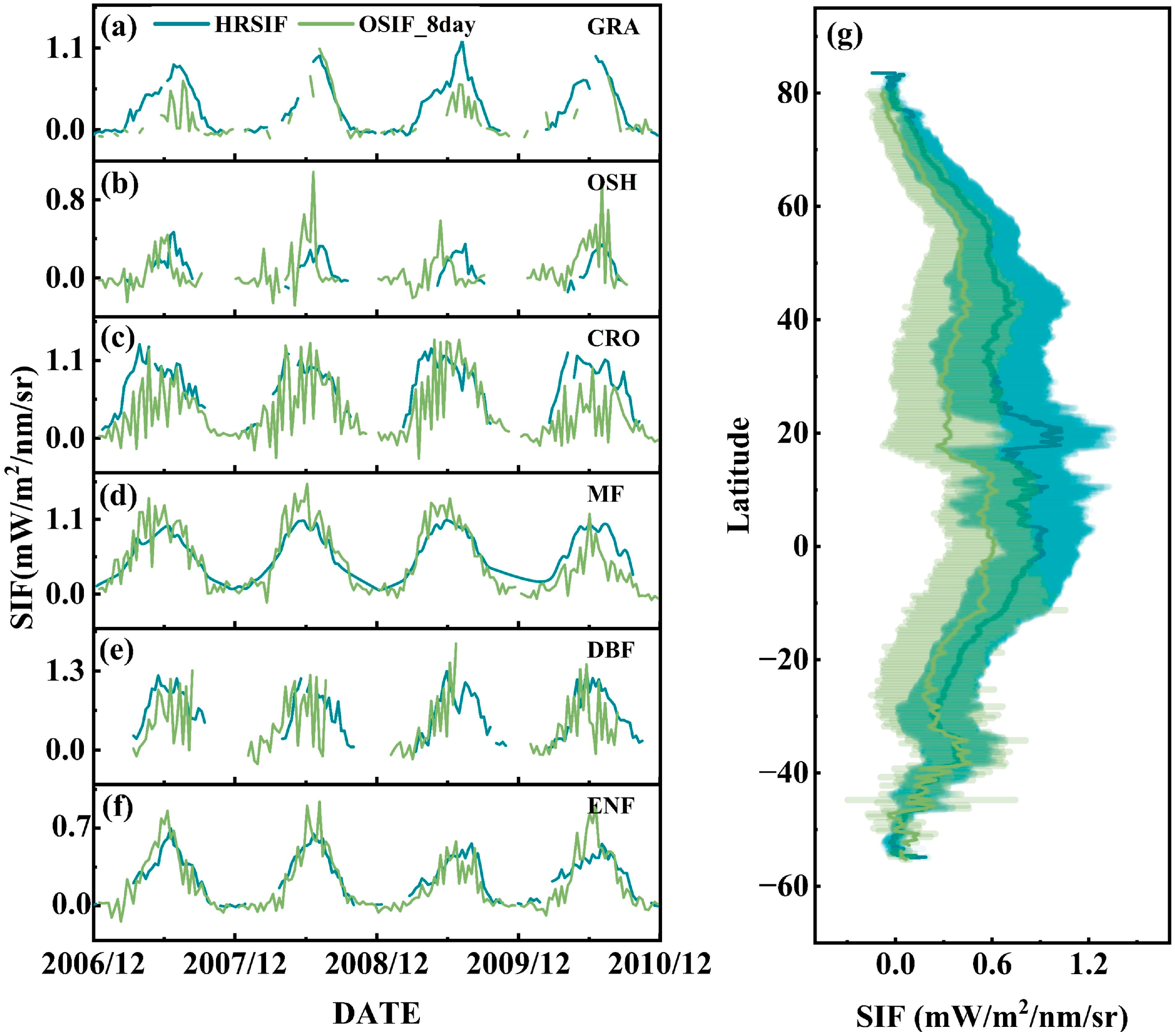
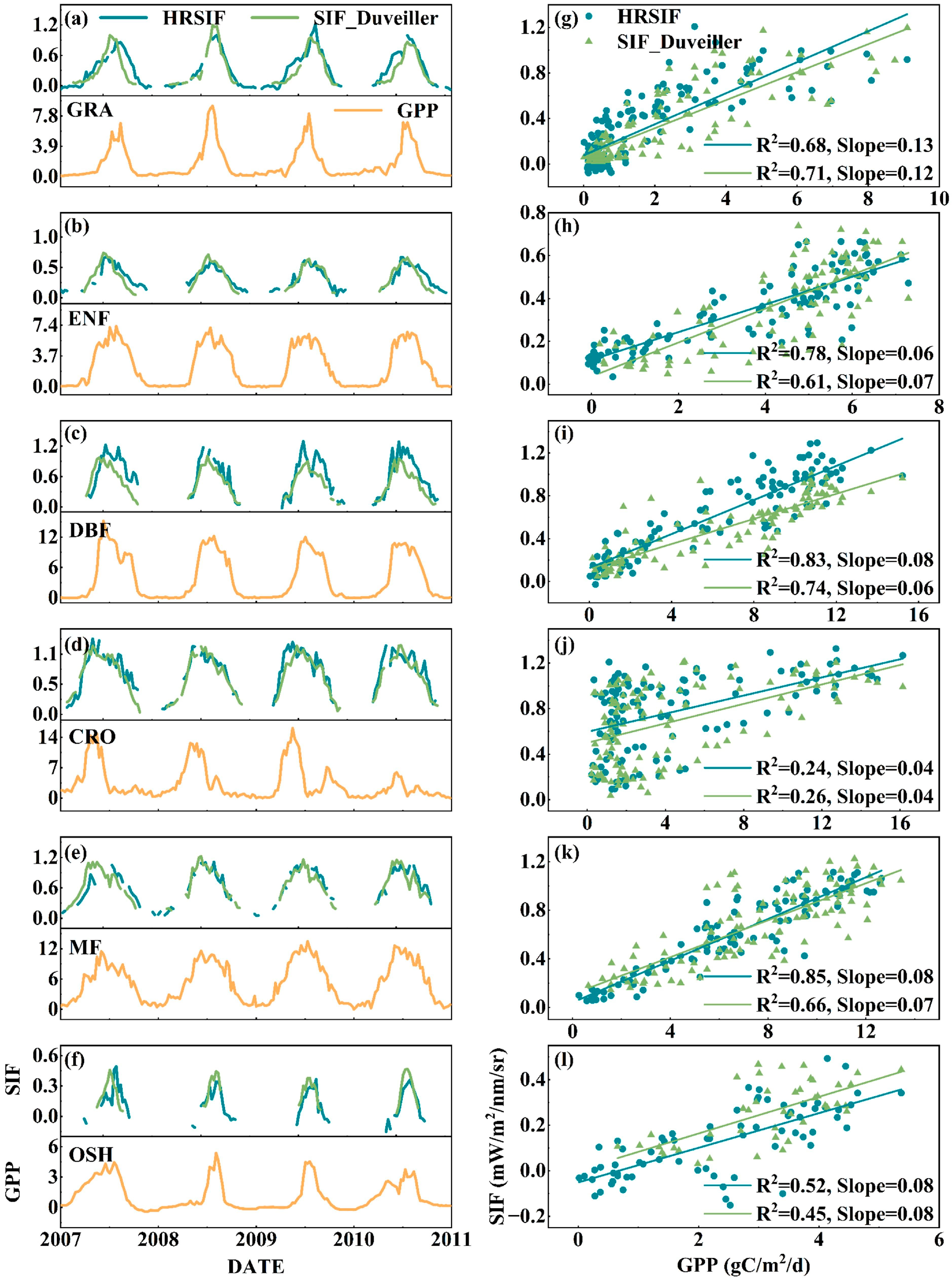
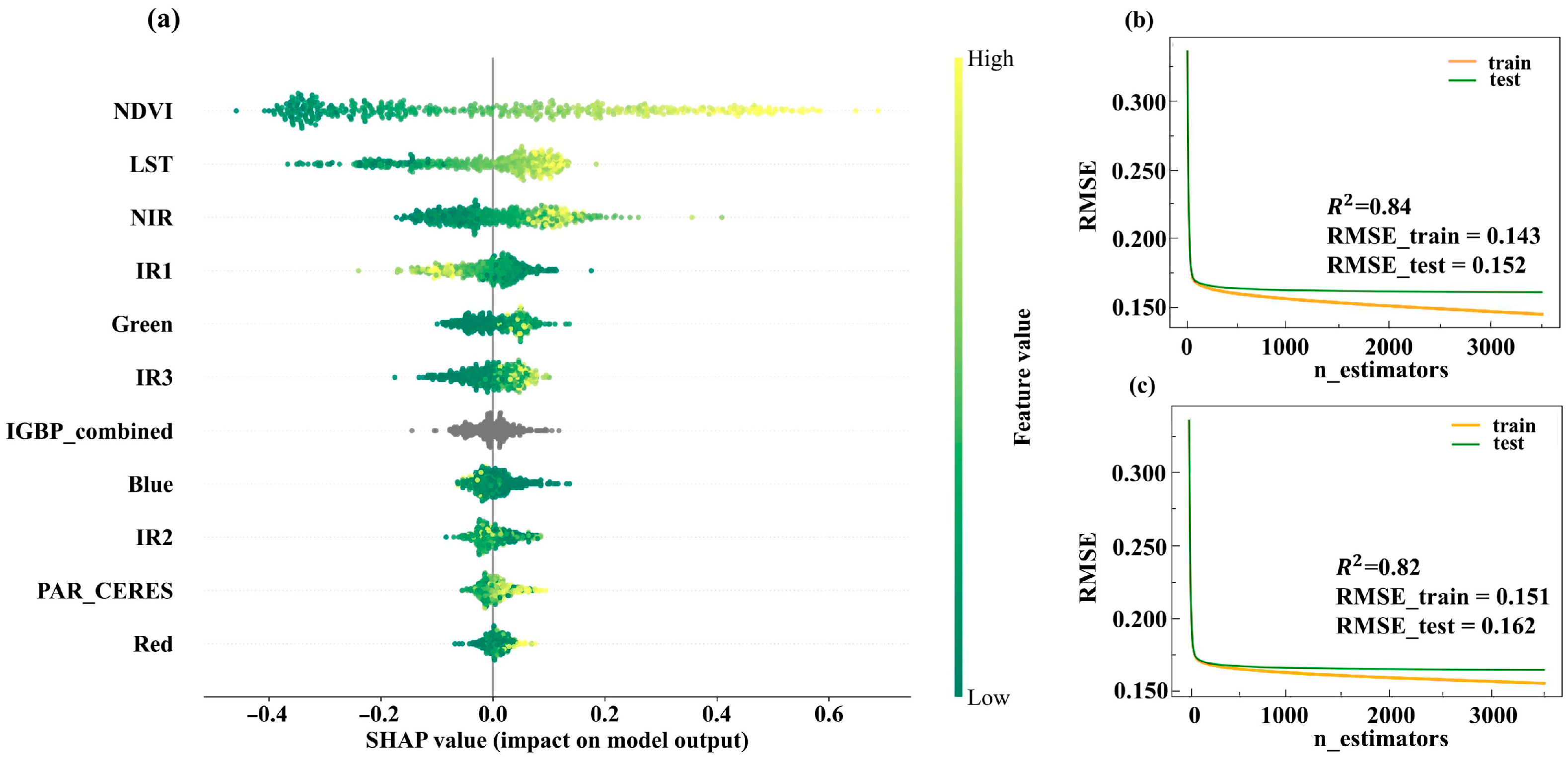
| Data | Resolution | Description | Source |
|---|---|---|---|
| MCD43C4 | 0.05° × 0.05° | NBAR: Nadir BRDF-Adjusted Reflectance | https://lpdaac.usgs.gov/products/mcd43c4v061/ (accessed on 5 June 2025) |
| MOD11C1 | 0.05° × 0.05° | LST: Land Surface Temperature | https://lpdaac.usgs.gov/products/mod11c1v061/ (accessed on 5 June 2025) |
| CERES_SYN1deg | 1° × 1° | PAR: Photosynthetically Active Radiation | https://ceres.larc.nasa.gov/data/# (accessed on 5 June 2025) |
| MCD12C1 | 0.05° × 0.05° | IGBP classification: Land Use/Land Cover type | https://lpdaac.usgs.gov/products/mcd12c1v061/ (accessed on 5 June 2025) |
| GOME-2 SIF | 0.5° × 0.5° | SIF: Sun-induced chlorophyll Fluorescence | ftp://ftp.gfz-potsdam.de/home/mefe/GlobFluo/ (accessed on 5 June 2025) |
| Parameters | Value |
|---|---|
| n_estimators | 3500 |
| min_child_weight | 3 |
| max_depth | 6 |
| learning_rate | 0.05 |
| tree_method | gpu_hist |
| Region | Pearson |
|---|---|
| Region 1 | 0.67 |
| Region 2 | 0.35 |
| Region 3 | 0.65 |
| Region 4 | 0.72 |
| Region 5 | 0.78 |
| Region 6 | 0.51 |
| All regions | 0.76 |
| Sites | IGBP Type | Latitude | Longitude |
|---|---|---|---|
| CN-CNG | GRA | 44.59 | 123.51 |
| CA-OBS | ENF | 53.99 | −105.12 |
| US-UMB | DBF | 45.56 | −84.71 |
| CH-OE2 | CRO | 47.29 | 7.73 |
| BE-VIE | MF | 50.30 | 5.99 |
| RU-COK | OSH | 70.83 | 147.49 |
Disclaimer/Publisher’s Note: The statements, opinions and data contained in all publications are solely those of the individual author(s) and contributor(s) and not of MDPI and/or the editor(s). MDPI and/or the editor(s) disclaim responsibility for any injury to people or property resulting from any ideas, methods, instructions or products referred to in the content. |
© 2025 by the authors. Licensee MDPI, Basel, Switzerland. This article is an open access article distributed under the terms and conditions of the Creative Commons Attribution (CC BY) license (https://creativecommons.org/licenses/by/4.0/).
Share and Cite
Hu, C.; Xie, P.; Hu, Z.; Li, A.; Feng, H. The Downscaled GOME-2 SIF Based on Machine Learning Enhances the Correlation with Ecosystem Productivity. Remote Sens. 2025, 17, 2642. https://doi.org/10.3390/rs17152642
Hu C, Xie P, Hu Z, Li A, Feng H. The Downscaled GOME-2 SIF Based on Machine Learning Enhances the Correlation with Ecosystem Productivity. Remote Sensing. 2025; 17(15):2642. https://doi.org/10.3390/rs17152642
Chicago/Turabian StyleHu, Chenyu, Pinhua Xie, Zhaokun Hu, Ang Li, and Haoxuan Feng. 2025. "The Downscaled GOME-2 SIF Based on Machine Learning Enhances the Correlation with Ecosystem Productivity" Remote Sensing 17, no. 15: 2642. https://doi.org/10.3390/rs17152642
APA StyleHu, C., Xie, P., Hu, Z., Li, A., & Feng, H. (2025). The Downscaled GOME-2 SIF Based on Machine Learning Enhances the Correlation with Ecosystem Productivity. Remote Sensing, 17(15), 2642. https://doi.org/10.3390/rs17152642






